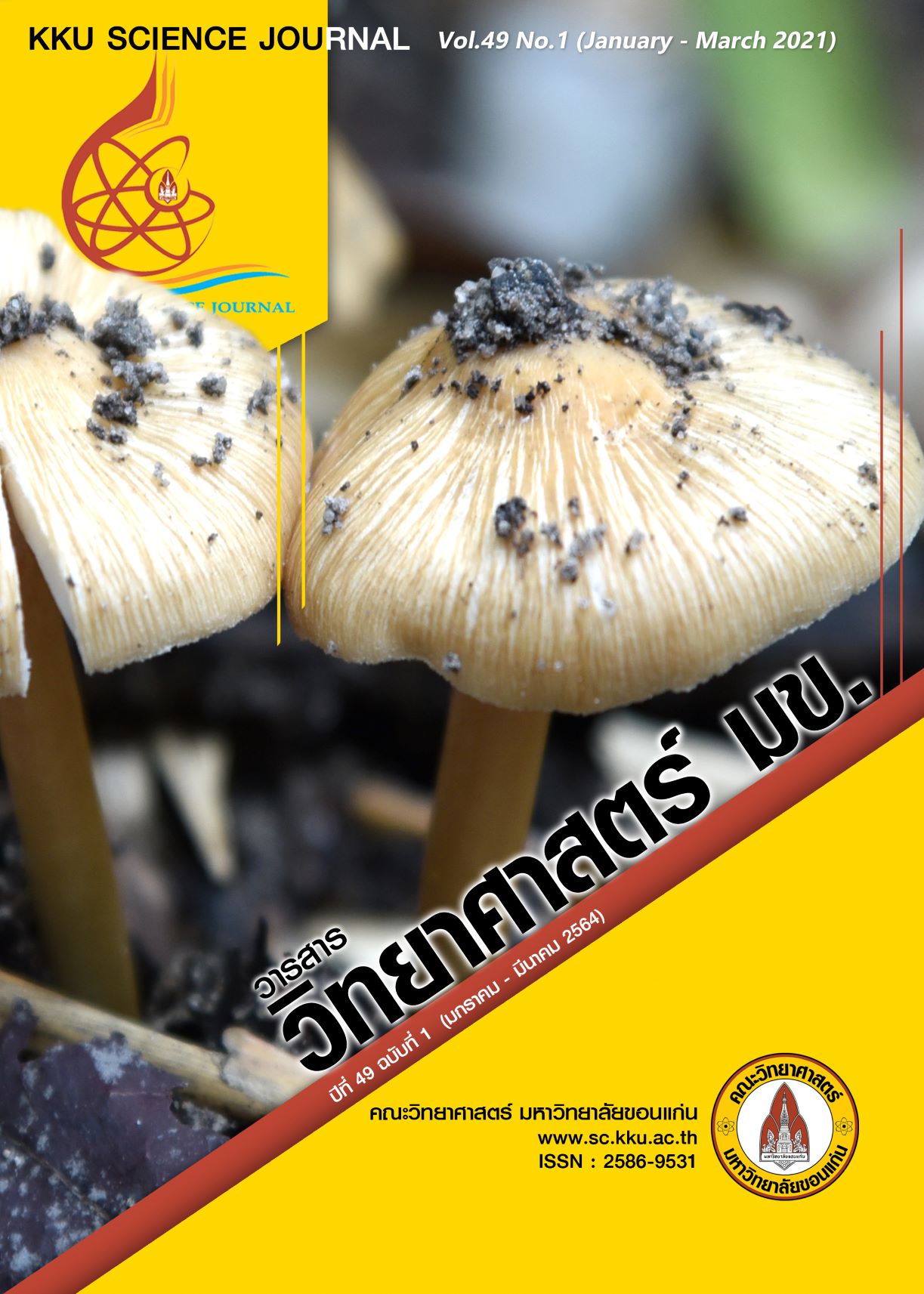Development of Antigen Preparation for Detecting Chicken Antibodies Directed Against Salmonella Enteritidis by Using Rapid Slide Agglutination
Main Article Content
Abstract
The aim of this study was to develop antigen preparation methods of Salmonella Enteritidis (SE) for rapid slide agglutination test (RSA) and to compare the methods between SE formalin inactivation and SE alcohol inactivation. Three groups of serum samples were prepared, including group 1 60 serum samples originated from healthy SE-negative chickens, group 2 20 serum samples originated from chickens injected with SE killed antigen, and group 3 20 serum samples originated from chickens infected with SE (106 CFU/bird). The result showed that all 60 serum samples from group 1 were tested and negative (100%) for RSA with either SE formalin inactivated antigen or SE alcohol inactivated antigen. In group 2, all serum samples were positive (100%) for RSA with SE formalin inactivated antigen and 19 samples were positive (95%) for RSA with SE alcohol inactivated antigen. In group 3 19 serum samples were positive (95%) for RSA with SE formalin inactivated antigens and 16 serum samples were positive (80%) for RSA with SE alcohol inactivated antigen. Furthermore, for testing a cross reactivity with S. Typhimurium (ST), the serum samples originated from either chickens injected with killed ST antigen or infected with ST (106 CFU/bird) were tested RSA with the antigen prepared and the result found that all serum samples were reacted to RSA with SE formalin inactivated antigen lower than to RSA with SE alcohol inactivated antigen (p<0.05). Finally, serum samples originated from 3 chicken flocks raised commercially with healthy and SE infected conditions were tested RSA with the antigen prepared and gave specific results for both healthy and infected flocks. In conclusion, RSA with SE formalin-inactivated antigens gave better results than the test with SE alcohol-inactivated antigens and both SE antigens prepared could be practically used with RSA for detecting the serum samples originated from the SE infected chicken flock.
Article Details

This work is licensed under a Creative Commons Attribution-NonCommercial-NoDerivatives 4.0 International License.
References
ณัฐา จริยภมรกุร วิชัย สุทธิธรรม และดรุณี ศรีชนะ. (2558). การสํารวจแบคทีเรียก่อโรคซึ่งปนเปื้อนในไข่ที่วางจําหน่ายในเขตอําเภอคลองหลวง จังหวัดปทุมธานี. Thai Journal of Science and Technology 4(1): 104-114.
ระเบียบกรมปศุสัตว์ว่าด้วยการควบคุมโรคแซลโมเนลลาสําหรับสัตว์ปีก. (2553, 8 ธันวาคม). ราชกิจจานุเบกษา. เล่ม 127 ตอนพิเศษ 140 ง. หน้า 2.
วรรณา พรรณรักษา สดใส เวชชาชีวะ และดิลก เย็นบุตร. (2521). การศึกษาเบื้องต้นในการหา Salmonella Typhi O antibody โดยวิธี slide agglutination test. จุฬาลงกรณเวชสาร 22 (4): 261-264.
สุมาลี เลี่ยมทอง. (2560). ความชุกของเชื้อ Salmonella ที่แยกจากเนื้อสัตว์ค้าปลีกในอําเภอเมืองจังหวัดนครศรีธรรมราช. วารสารวิชชา 36(1): 72-85
อดิศร ดวงอ่อนนาม คมกริช พิมพ์ภักดี และปิยวัฒน์ สายพันธุ์. (2554). ความชุกและซีโรวาร์ของซัลโมเนลลาในเนื้อโคที่จําหน่ายข้างถนนจากขั้นตอนการตัดแต่งซากในโรงฆ่าสัตว์การขนส่งซากและร้านจําหน่ายในจังหวัดร้อยเอ็ด. ใน: รายงานการประชุมวิชาการเสนอผลงานวิจัยระดับบัณฑิตศึกษาครั้งที่ 12 มหาวิทยาลัยขอนแก่นขอนแก่น. 1105-1115.
Barrow, P. A., Berchieri, A., Jr. and Al-Haddad, O. (1992). Serological response of chickens to infection with Salmonella Gallinarum-S. Pullorum detected by enzyme-linked immunosorbent assay. Avian Diseases 36(2): 227-236.
Barrow, P. A., Bumstead, N., Marston, K., Lovell, M. A. and Wigley, P. (2004). Faecal shedding and intestinal colonization of Salmonella Enterica in in-bred chickens: the effect of host-genetic background. Epidemiology and Infection 132(1): 117-126.
Barrow, P. A., Jones, M. A., Smith, A. L. and Wigley, P. (2012). The long view: Salmonella-the last forty years. Avian Pathology 41(5): 413-420.
Gast, R. K. (1997). Detecting infections of chickens with recent Salmonella Pullorum isolates using standard sero-logical methods. Poultry Science 76(1): 17-23.
Gast, R. K., Guard-Petter, J. and Holt, P. S. (2002). Characteristics of Salmonella Enteritidis contamination in eggs after oral, aerosol, and intravenous inoculation of laying hens. Avian Diseases 46(3): 629-635.
Van Immerseel, F., De Buck, J., Pasmans, F., Bohez, L., Boyen, F., Haesebrouck, F., and Ducatelle, R. (2004). Intermittent long-term shedding and induction of carrier birds after infection of chickens early posthatch with a low or high dose of Salmonella Enteritidis. Poultry Science 83(11): 1911-1916.
Jones, F. S. (1913). The value of the macroscopic agglutination test in detecting fowls that are harboring Bact. Pullorum. Journal of Medical Research 27(4): 481-495.
Kim, C. J., Nagaraja, K. V. and Pomeroy, B. S. (1991). Enzyme-linked immunosorbent assay for the detection of SalmonellaEnteritidis infection in chickens. American Journal of Veterinary Research 52(7): 1069-1074.
Kolmer, J. A., Spaulding, E. H. and Robinson, H. W. (1951). Approved laboratory technic, 5th ed New York: Appleton-Century-Crofts. pp. 751-756.
OIE. (2019). Chapter 3.9.8. Salmonellosis. Manual of diagnostic tests and vaccines for terrestrial animals (2019). https://www.oie.int/standard-setting/terrestrial-manual /access-online/
Runnels, R. A., Coon, C. J., Farley, H. and Thorp, F. (1927). An application of the rapid method agglutination test to the diagnosis of bacillary white diarrhea infection. Journal of the American Veterinary Medical Association 70: 660-662.
Schaffer, J. M., MacDonald, A. D., Hall, W. J. and Bunyea, H. (1931). A stained antigen for the rapid whole blood test for pullorum disease. Journal of the American Veterinary Medical Association 79: 236-240.
Sumithra, T. G., Chaturvedi, V. K., Rai, A. K., Sunita, S. C. C., Susan, C. and Siju, S. J. (2013). Development of slide agglutination test for the differentiation of SalmonellaTyphimurium infection from poultry specific salmonella serovars. Journal of Veterinary Public Health 11(2): 83-90.
Shivaprasad, H. L., Timoney, J. F., Morales, S., Lucio, B. and Baker, R. C. (1990). Pathogenesis of Salmonella Enteritidis infection in laying chickens. I. Studies on egg transmission, clinical signs, fecal shedding, and serologic responses. Avian Diseases34(3): 548-557.
Tanaka, S. (1975). Production of pullorum antigen by continuous submerged culture. Japan Agricultural Research Quarterly 9(1): 60-65.
Timoney, J. F., Sikora, N., Shivaprasad, H. L. and Opitz, M. (1990). Detection of antibody to Salmonella Enteritidis by a gm flagellin-based ELISA. Veterinary Record 127(7): 168-169.
Waltman, W. D. and Horne, A. M. (1993). Isolation of Salmonella from chickens reacting in the pullorum-typhoid agglutination test. Avian Diseases37(3): 805-810.
Yang, B., Niu, Q., Yang, Y., Dai, P., Yuan, T., Xu, S., Pan, X., Yang, Y. and Zhu, G. (2019). Self-made Salmonella Pullorum agglutination antigen development and its potential practical application. Poultry Science 98(12): 6326-6332.


